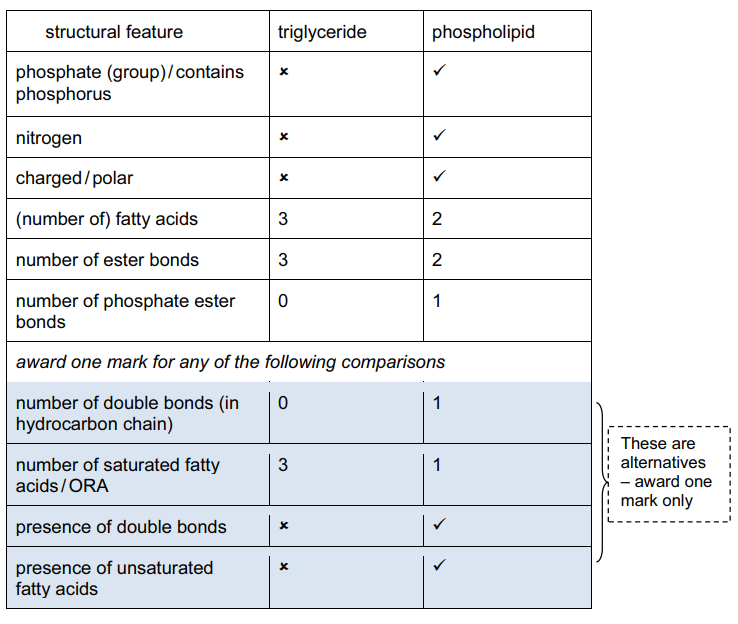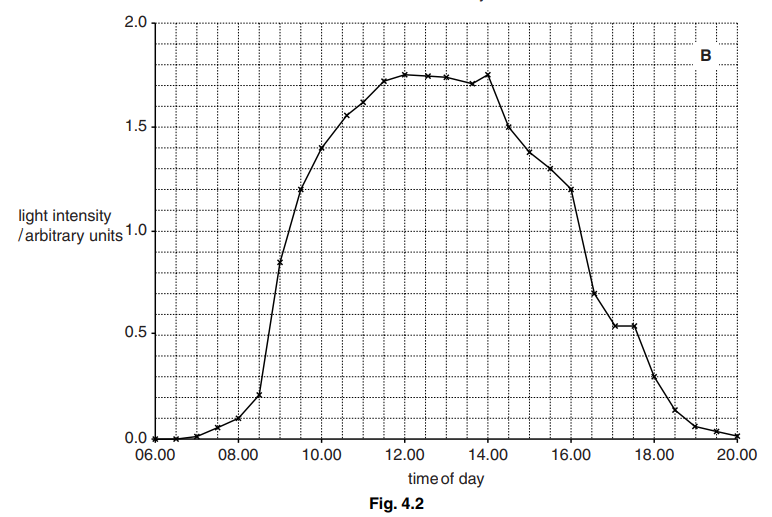Question
Fig. 5.1 shows a diagram of the molecular structures of tristearin (a triglyceride) and phosphatidylcholine (a phospholipid).

(a) Table 5.1 shows a structural difference between the two molecules shown in Fig. 5.1.
Complete Table 5.1 with two further structural differences other than in numbers of different types of atoms.[2]

(b) Cells in the pancreas secrete enzymes, such as amylase and trypsin, into a duct.
The enzymes are packaged in vesicles so that they can be exported from these cells as shown in Fig. 5.2.

With reference to Fig. 5.2, explain how enzymes that are secreted by cells in the pancreas are packaged into vesicles and exported.[4]
(c) Water has many significant roles to play in cells and living organisms.
Complete Table 5.2 below by stating the property of water that allows each of the following to take place.[3]

[Total: 9]
Answer/Explanation
Ans:
5 (a)

(b) answer may be phrased in the context of amylase/ trypsin ignore anything before Golgi, e.g. shuttle vesicles from RER
1 vesicles, form from/ ‘pinch off’, Golgi (apparatus /body / complex) ;
2 vesicles moves, through cytoplasm/ to cell (surface) or plasma membrane ;
3 role of cytoskeleton/ microtubules in movement of vesicles ;
4 energy /ATP, is required (movement of vesicles / fusion with membrane) ;
5 vesicle fuses with/AW, cell (surface)/ plasma, membrane ;
I bind/ attach A join/ merge/ becomes part of
6 exocytosis / vesicle ‘opens up’ so that enzyme molecules are released ;
7 ref to fluid nature of, membranes / phospholipid bilayer, that makes this possible ;
(c)

Question
(a) Transpiration is often described as ‘an inevitable consequence of gas exchange in leaves’.
Explain what is meant by this description.[3]
(b) Explain how hydrogen bonding is involved in the movement of water in the xylem.[3]
Southern beech trees of the genus Nothofagus grow in forests in the South Island of New Zealand. Fig. 4.1 shows a small part of a forest.
Most of the trees in the forests form a thick canopy of leaves. These are known as canopy trees. The tallest trees are known as emergent trees. Some trees do not reach the canopy and are known as suppressed trees.

Researchers determined the rates of transpiration of emergent, canopy and suppressed trees in a forest over a 14 hour period from 06.00 until 20.00 on one day in the summer. The results are shown in Fig. 4.2A. They also recorded changes in light intensity above the canopy over the same time period as shown in Fig. 4.2B.


(c) Use Fig. 4.2A to compare the transpiration rates of the emergent, canopy and suppressed trees in the forest over 14 hours.[4]
(d) The factors that affect transpiration rate vary considerably at different places inside forests.
Use the information in Fig. 4.1 and Fig. 4.2 to suggest reasons for the difference in the transpiration rates of the emergent and suppressed trees.[4] [Total: 14]
Answer/Explanation
Ans:
4 (a) transpiration is an inevitable consequence because
1 stomata open ;
2 for diffusion in of carbon dioxide/ carbon dioxide required for photosynthesis ;
3 water vapour, diffuses out/moves out down the water potential gradient ;
A description of water potential gradient/ high to low water potential
A vapour pressure gradient/water vapour gradient
allow water vapour if it is clear that evaporation has occurred
A water evaporates and diffuses out
R water evaporates out
I water (vapour) concentration gradient
(b) 1 adhesion of water to, cellulose/ lining/walls (of xylem vessels) ;
A adhesive force
2 ref to, hydrophilic / polar, property of cellulose (fibres) ;
A hydrophilic / polar, parts of lignin
3 cohesion between water molecules ; cohesive force
4 maintains column of water/ prevents water column breaking/AW ;
5 ref. to transpiration pull/AW ; I transpiration unqualified
(c) mp3 – units for rates of transpiration must appear once correctly in the whole answer to award this point
1 rate (of transpiration) of all trees is 0 at, 06.00/ start ; A no transpiration
2 rates (of transpiration) increase and decrease (in all three) ; A peaks
3 highest rates:
emergent trees at 14.30 at 8.5kgh–1
canopy trees at 14.30 at 3.5kgh–1
suppressed trees at 13.00 at 1.6–1.7kgh–1 ;
must have units at least once
accept kg/h or kg per hour
4 emergent trees (always) have highest rate or suppressed trees have lowest rate ;
A emergent trees have higher rate than, canopy and suppressed, trees
5 rate of emergent trees is, much/AW, higher than rates for canopy and suppressed trees ;
6 emergent trees have, steeper/ steepest, increase in (transpiration) rate ;
A emergent trees have, steeper/ steepest, decrease in (transpiration) rate
(d) following factors may be given in answers, any three of these factors = 1 mark
light, intensity /wavelength I ‘more light’
humidity
temperature
wind speed/ air movement
size of tree/ height/ area of leaves
water availability / depth or length of roots
transpiration rate for emergent trees is higher because … accept ora for
suppressed trees
accept vapour pressure gradient/water vapour pressure gradient/water vapour
diffusion gradient for water potential gradient
1 high(er) light intensity for emergent trees increase in stomatal aperture ; ora
A more sunlight
A stomata open more
I more stomata open
2 lower humidity for emergent trees so steeper water potential gradient ; ora
A description of water potential gradient
3 higher temperature/AW, for emergent trees so higher rate of,
evaporation/ diffusion ; ora
4 higher wind speed for emergent trees so, steeper water potential
gradient/ lower humidity ; ora
A ref. to diffusion shells / descriptions of water potential gradient
5 emergent trees have longer roots so take up more water ;
6 emergent trees have more leaves so, greater surface area/more stomata per unit area (of leaf) ;
Question
(a) (i) Define transpiration.[1]
(ii) State two environmental factors that affect the rate of transpiration.
Explain how each factor affects the rate of transpiration.[4]
factor 1
explanation
factor 2
explanation
(b) Explain how hydrogen bonding is involved in the movement of water through the xylem.[3] [Total: 8]
Answer/Explanation
Ans:
2 (a) (i) loss of water vapour from the, leaves /aerial parts of a plant ;
R water evaporates from the surface of the leaf
(ii) each factor 1 mark, explanation for each factor 1 mark
look for ora for explanation
temperature ; I high /low or hot / cold
increased temperature, increased rate as higher rate of, evaporation (from spongy cell surfaces)/ diffusion (of water vapour out via stomata)
or
at very high temperature stomata close so transpiration, stops / slows ;
humidity ; I high /low
one from
increased humidity, decreased rate as, less steep water potential gradient / decreased diffusion rate (of water vapour out via stomata) ;
wind (speed)/ air movement ; I fast / slow
higher wind speed steeper, water potential gradient / higher diffusion rate
(of water vapour out via stomata)/ diffusion shells do not build up / wind moves moist air away /AW
or
at high wind speed the stomata close so transpiration slows ;
water availability ; I high/ low
reduced water availability causes stomata to close (so reduced rate of diffusion )
or
more water available, steeper water potential gradient between roots and leaves ;
light intensity ; I high / low
higher light intensity, increased rate as stomata open more widely
A more light (as ecf from stating factor)
or
at very high light intensity the stomata close so transpiration slows ; A stops
(b) three from
cohesion and adhesion ; in correct context
transpiration stream / transpiration pull ; A continuous column of water moving up (to leaves)
attraction/ cohesion, between water molecules ; A water is cohesive
A stickiness between water molecules
adhesion /AW, of water molecules to lining of xylem (vessels) ;
only needs ‘molecules’ once
adhesion to/AW, cellulose molecules /hydrophilic parts of lignin ;
